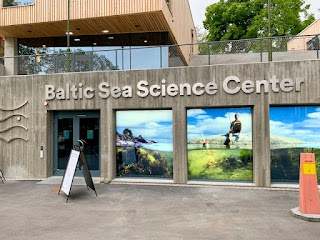New! Baltic Sea Science Center
The other day, the Djurgården Society invited Stockholm hotel staff (including me) on a tour of some of the many attractions located on Djurgården ahead of the busy summer season. Djurgården is a big park complex (the world's first national city park) and the location of many of Stockholm's main tourist attractions, like museums, art galleries, restaurants, theatres and amusement parks. Because of this, it quite unique and attracts over 15 million visitors annually. Chances are, if you visiting Stockholm for leisure, you will spend some time in Djurgården.
While I have visited almost all of these attractions (and written about them), we were lucky enough to be given a tour of a brand new attraction here... The Baltic Sea Science Center. This is an aquarium and science center, dedicated to the creatures that make the Baltic Sea their home and the environmental preservation of this interesting sea. The Center is located within the larger Skansen park and is included with the entrance ticket to Skansen.
Skansen, in general, is an interesting place to visit. Not only is it the zoo, filled with Scandinavian animals like bears, moose, wolves and reindeer, it is also an open-air museum where you can see what pastoral and town life looked like in different parts of Sweden during the 1800's. In fact, created in 1891, it is the world's first open-air museum.
The Baltic Sea Science Center is the latest addition to the park and it was nice to see the sea life of Sweden highlighted. The Baltic Sea is quite unique as it is a large brackish sea (a mix of fresh and salt water). The only connection it has to the ocean is through a very narrow straight that separates Sweden from Denmark in the south.
The various tanks in the aquarium take you through the different habitats of the Baltic, from the shallows to the open ocean, and the creatures that live there. They have salmon, cod, herring, mussels, jellyfish, sturgeon, flounders and much more. One of the tanks has a tunnel, so you can walk through and see the fish swimming above you. The Baltic Sea has a fragile ecosystem and part of the Center is dedicated to the preservation of the sea, the different factors that affect the ecosystem and how countries around the Baltic are working to make sure this sea can be enjoyed by future generations.
Skansen and the Center, as I have mentioned, are located on Djurgården. The easiest way to get there from the Hotel Rival is to take the Djurgård Ferry from nearby Gamla Stan. The ferries depart every 15 minutes and it is just a 10 minute trip. You can also get there from the downtown area, using the Djurgård tram. Both the ferry and the tram are part of the Stockholm public transportation system.
While I have visited almost all of these attractions (and written about them), we were lucky enough to be given a tour of a brand new attraction here... The Baltic Sea Science Center. This is an aquarium and science center, dedicated to the creatures that make the Baltic Sea their home and the environmental preservation of this interesting sea. The Center is located within the larger Skansen park and is included with the entrance ticket to Skansen.
Skansen, in general, is an interesting place to visit. Not only is it the zoo, filled with Scandinavian animals like bears, moose, wolves and reindeer, it is also an open-air museum where you can see what pastoral and town life looked like in different parts of Sweden during the 1800's. In fact, created in 1891, it is the world's first open-air museum.
The Baltic Sea Science Center is the latest addition to the park and it was nice to see the sea life of Sweden highlighted. The Baltic Sea is quite unique as it is a large brackish sea (a mix of fresh and salt water). The only connection it has to the ocean is through a very narrow straight that separates Sweden from Denmark in the south.
The various tanks in the aquarium take you through the different habitats of the Baltic, from the shallows to the open ocean, and the creatures that live there. They have salmon, cod, herring, mussels, jellyfish, sturgeon, flounders and much more. One of the tanks has a tunnel, so you can walk through and see the fish swimming above you. The Baltic Sea has a fragile ecosystem and part of the Center is dedicated to the preservation of the sea, the different factors that affect the ecosystem and how countries around the Baltic are working to make sure this sea can be enjoyed by future generations.
Skansen and the Center, as I have mentioned, are located on Djurgården. The easiest way to get there from the Hotel Rival is to take the Djurgård Ferry from nearby Gamla Stan. The ferries depart every 15 minutes and it is just a 10 minute trip. You can also get there from the downtown area, using the Djurgård tram. Both the ferry and the tram are part of the Stockholm public transportation system.









Comments
Post a Comment